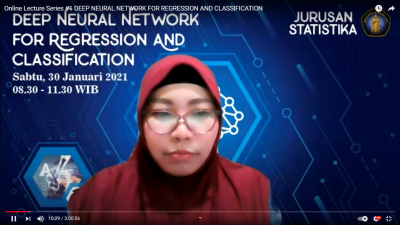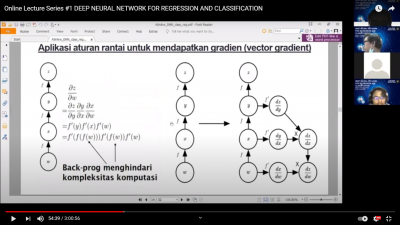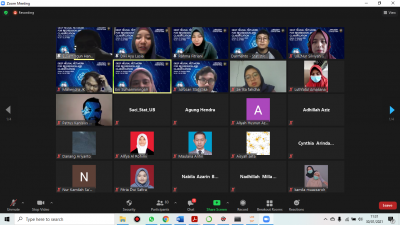Workshop OLS#1 Deep Neural Network Regression and Classification
Saturday, 30 January 2021 – Department of Statistics, Faculty of Mathematics and Natural Sciences (FMIPA) Universitas Brawijaya held Online Lecture Series#1, furthermore called as OLS#1. OLS#1 is an internal activity carried out by online as a response to the COVID-19 pandemic. This activity is from, by and for the academic community in the internal environment of the Statistics Department. The main objective of OLS#1 is to add insight and comprehend the topics of statistical science for Lecturers, Education Personnel, and Students in the Statistics Department.

The first series of OLS#1 activities selected the theme “Deep Neural Network (DNN) for Regression and Classification” with the speaker, Mr. Samingun Handoyo, S.Si., M.Cs. who is a statistics lecturer and a Ph.D. from the Department of Electrical Engineering and Computer Science-International Graduate Program, National Chiao Tung University – Taiwan. OLS#1 activity started at 08.15 WIB by playing Statistics Department profile video. At 08.30 WIB precisely, the event was opened by the Head of the Statistics Department, Mrs. Rahma Fitriani, S.Si., M.Sc., Ph.D which hope this event can run smoothly and be useful to add insight to the workshop participants because of contains material and practice directly using the software.
OLS#1 activity is divided into 2 sessions, the first session is delivering DNN material for 60 minutes. The speaker explained about the DNN application for classification. The presenter used 60,000 image dataset which used for classification. For 1 image represented by 28×28 cells, then the image will be converted into a digital value between 0 to 255. The speaker divides 60,000 datasets into 3 parts, 50,000 as training (45,000 real training and 5000 validations) and 10,000 testing data. The result is a graph showing that the actual image 7 is 7 with DNN modeling producing output is 7 as well. Then the speaker do a comparison of level accuracy in the 2 models. The model which shows the greater accuracy value, that is the best model.

In the application of DNN for regression applications, the speaker wants to know the ratio of covid-19 to the exchange rate. Data is taken from WHO for 5 countries, such as Indonesia, Malaysia, Japan, France and the USA on the exchange rate (exchange rate to the rupiah). The presenters perform modeling and forecasting with a regularization scheme. Regularization aims to make the model used optimally and not over-fitting. Actually, in statistics we use gulud regression or lasso regression. Ridge regression is a regression given regularization or absolute parameters.

The next 60 minutes is a practical session using python software. Participants are asked directly by the presenter to try on their own laptops in order to find out DNN’s performance. This OLS#1 activity is in great demand by students, because the number of registrants as many as 167 students with a total arrival of 110 students in the Zoom application and 17 lecturers of the Statistics Department. Even though during the activity there were network problems that caused the voice of the speaker is unstable to hear, the participants really appreciated this activity and hoped that the Statistics Department would be pleased to hold back events with themes such as Python – R Basics for the COVID-19 case, Data Mining, Bayes Analysis for Gene Expression Data, Statistical Modeling for Natural Language Processing, Machine Learning for Text and Images (Editor: DAR / NSR).
